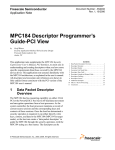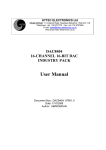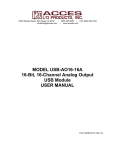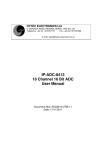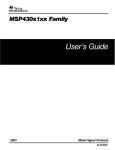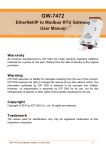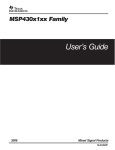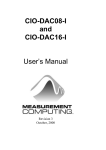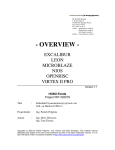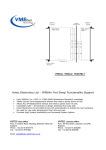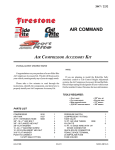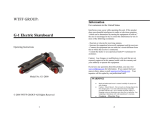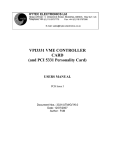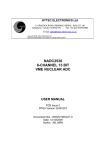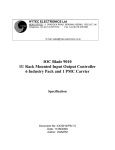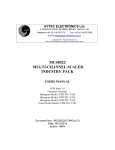Download User Manual - Hytec Electronics Ltd
Transcript
HYTEC ELECTRONICS Ltd HEAD OFFICE: 5 CRADOCK ROAD, READING, BERKS. RG2 0JT, UK Telephone: +44 (0) 118 9757770 Fax: +44 (0)118 9757566 E-mail: [email protected] Copyright 2010 Hytec Electronics Ltd Data and specifications are subject to change without notice DAC8415 16-CHANNEL 18-BIT DAC INDUSTRY PACK USERS MANUAL PCB Issue 1.0 Firmware Version 8415V102 Document Nos.: DAC8415/UTM/G/x/1.1 Date: 09/02/2012 Author: MRN Hytec Electronics Ltd 8415/UTM/G/2/1.1 Revision History The following table shows the revision history for this document. Date Version 21/10/10 09/02/12 1.0 1.1 Revision Initial release. Tidy up of manual. CRITICAL APPLICATIONS DISCLAIMER THIS PRODUCT FROM HYTEC ELECTRONICS LTD USES COMPONENTS THAT ARE NOT DESIGNED OR INTENDED TO BE FAIL-SAFE, OR FOR USE IN ANY APPLICATION REQUIRING FAIL-SAFE PERFORMANCE, SUCH AS IN LIFE-SUPPORT OR SAFETY DEVICES OR SYSTEMS, CLASS III MEDICAL DEVICES, NUCLEAR FACILITIES, APPLICATIONS RELATED TO THE DEPLOYMENT OF AIRBAGS, OR ANY OTHER APPLICATIONS THAT COULD LEAD TO DEATH, PERSONAL INJURY OR SEVERE PROPERTY OR ENVIRONMENTAL DAMAGE (INDIVIDUALLY AND COLLECTIVELY, “CRITICAL APPLICATIONS”). FURTHERMORE, SOME COMPONENTS USED IN THIS HYTEC ELECTRONICS LTD PRODUCTS ARE NOT DESIGNED OR INTENDED FOR USE IN ANY APPLICATIONS THAT AFFECT CONTROL OF A VEHICLE OR AIRCRAFT, UNLESS THERE IS A FAIL-SAFE OR REDUNDANCY FEATURE AND A WARNING SIGNAL UPON FAILURE TO THE OPERATOR. THE CUSTOMER ASSUMES THE SOLE RISK AND LIABILITY OF ANY USE OF HYTEC ELECTRONICS LTD PRODUCT IN CRITICAL APPLICATIONS. Page 2 Hytec Electronics Ltd 8415/UTM/G/3/1.1 CONTENTS 1. INTRODUCTION .............................................................................................................................. 4 2. PRODUCT SPECIFICATIONS ....................................................................................................... 5 3. OPERATING MODES ...................................................................................................................... 6 3.1 3.2 USING REGISTER TO UPDATE DACS..................................................................................... 6 USING MEMORY TO UPDATE DACS...................................................................................... 6 4. MEMORY MAP ................................................................................................................................. 7 5. APPLICATION REGISTERS .......................................................................................................... 8 5.1 5.2 5.3 5.4 5.5 5.6 5.7 5.8 5.9 6. CONTROL & STATUS REGISTER (CSR) ......................................................................................... 8 MEMORY POINTER ........................................................................................................................ 9 NUMBER OF UPDATES (NOC) ....................................................................................................... 9 CLOCK RATE ................................................................................................................................. 9 INTERRUPT VECTOR .................................................................................................................... 10 EXTENDED CONTROL & STATUS REGISTER (CSR EXT) ............................................................. 10 DIGITAL POTENTIOMETER DATA REGISTER ............................................................................... 11 DAC REGISTERS ......................................................................................................................... 11 DIGITAL POTENTIOMETER CALIBRATION REGISTERS ................................................................. 11 MULTI TRIGGER AND REPEAT MULTI TRIGGER MODE ................................................ 12 6.1 6.2 MULTI TRIGGER MODE ............................................................................................................... 12 REPEAT MULTI TRIGGER MODE ................................................................................................. 12 7. ID PROM........................................................................................................................................... 13 8. POWER UP AND POWER DOWN AND RESET OF 8415 DAC .............................................. 14 8.1 8.2 8.3 9. POWER UP ................................................................................................................................... 14 POWER DOWN ............................................................................................................................. 14 IP RESET ..................................................................................................................................... 14 CHANGING RANGE OF 8415 DAC ............................................................................................. 15 10. RANGE RESOLUTION AND INSTALLATION CONSIDERATIONS................................ 16 11. EPICS AND ASYN SOFTWARE DRIVER PLUS LINUX/WINDOWS API........................ 16 12. SELECTION OF THE +/-12 VOLT POWER SUPPLY .......................................................... 16 APPENDIX A............................................................................................................................................ 17 APPENDIX B............................................................................................................................................ 18 APPENDIX C............................................................................................................................................ 19 APPENDIX D............................................................................................................................................ 20 Page 3 Hytec Electronics Ltd 8415/UTM/G/4/1.1 1. INTRODUCTION The Hytec IP-DAC-8415 is a single-width Industry Pack that provides 16 channels of simultaneously updated digital to analogue conversion with the following characteristics:• 16 independently programmed channels • 18 bits resolution – 18 bits monotonic. • 16 or 18 bit operation selectable by hardware or software • On board RAM Memory 1Meg x 16 bits (64K samples for 16bits) (32K samples for 18bits). • +/-10V full scale output range * • +/-5V full scale output range • 0 to 10V full scale output range • 0 to 5V full scale output range • Ranges software selectable • +/- 10mA current drive capability with continuous short-circuit protection • Drives capacitive loads to 10000pF • Straight binary or Two Complement input code • Internal/External update clock rates • Internal update clock rates programmable (50KHz,20KHz,10KHz,5KHz,2KHz,1KHz,500Hz,200Hz,100Hz,50Hz,20Hz,10Hz,5Hz,2Hz and 1Hz) • Maximum 64KHz external clock rate • Simultaneous up-date Power-on disable (outputs set to 0V on boot up) • System to plant isolation to 100V when externally powered • Board type, Board serial number, PCB issue and firmware version held on ROM. • External Triggering • Continuous function generation. • Multi Trigger Mode. • Repeat Multi Trigger Mode. • Field upgradeable firmware (requires Xilinx/compatible device to program built in FPGA flash memory via the FPGA JTAG port). * The units are factory set to have an output range of +/-10V on power up. Page 4 Hytec Electronics Ltd 8415/UTM/G/5/1.1 2. PRODUCT SPECIFICATIONS Size: Single width Industry Pack 1.8ins x 3.9 ins Operating temp: 0 to 45 deg C ambient Number of channels: 16 DAC resolution: 18 bits Data format +/-10V: 18 bits straight binary Code format 20h = –10v, 20000h = 0V and 3FFE0h = +10V. Data format +/-5V: 18 bits straight binary Code format 40h = –5v, 20000h = 0V and 3FFC0h = +5V. Data format 0-10V: 18 bits straight binary Code format 0000h = 0V and 3FFC0h = +10V. Data format 0-5V: 18 bits straight binary Code format 0000h = 0V and 3FFC0h = +5V. Output current: +/-10mA @ FS Capacitive load: Stable up to 10000pF Short circuit duration: Continuous OverV withstand: No internal protection from external voltages provided Update rate: 64KHz max Power quiescent: +5V @ 350mA typical +12V @ 150mA typical -12V @ 100mA typical Isolation: 100V via opto-isolators (if externally powered by HYTEC 8912) DAC device: Texas Instruments DAC9881SB with serial interface Integral non-linearity: +/-1LSBs typ. +/-2LSBs max Offset error: +/- 32LSBs without calibration (+/-2LSBs after firmware calibration) at 25 deg C ambient. (Guaranteed for +/-10V range only). Offset drift: +/-0.8 ppm per deg C typical Gain error: +/- 32LSBs without calibration (+/-2LSBs after firmware calibration) at 25 deg C ambient. (Guaranteed for +/-10V range only). Gain drift: +/-10V range +/-2 ppm per deg C typical +/-5V range +/-4 ppm per deg C typical 0-10V range 2 ppm per deg C typical 0-5V range 0.8 ppm per deg C typical Output slew rate: 1.6V/us typ. Page 5 Hytec Electronics Ltd 8415/UTM/G/6/1.1 3. Operating Modes There are two operating modes:1. Registered – the DAC outputs are controlled by the contents of the DAC registers. 2. Memory – the DAC outputs are updated for the programmed number of samples at the programmed clock rate from the RAM memory. All the outputs are updated serially but change together (there will be slight changes due to differences in the slew rate of the amplifiers (about +/-1uS) at the end of an internal update cycle. The outputs may be updated at a rate of up to 64KHz. The two methods to update the 8415 DACs are detailed below. 3.1 USING REGISTER TO UPDATE DACs For this mode set EX=’0’ and ARM=’1’ in the CSR. In 18bit mode there are two registers per DAC channel giving a torla of 32 registers. These can be loaded one at a time, the module can then be ARMed and the data from the registers will be serially loaded from one DAC to the next until all the data has been passed to the DACs. At this point the DAC outputs are automatically updated giving 16 simultaneous outputs. Then ARM bit is cleared. In this mode the output sample clock is not used as the output is set when ARM is set. All the outputs change together. 3.2 USING MEMORY TO UPDATE DACs To select this mode set the following bits:-EX=’1’, ARM=’1’ in the CSR. Trigger using software trigger (ST) or external hardware trigger. In this method the memory is first loaded with the required data and the number of memory locations used is entered in to the Number of Updates (NOC) register. The Control and Status Register (CSR) is then set to enable memory updates and ARM to unit with a software command. A trigger can then be issued either by a software command or by an external trigger to start down loading the data held in memory to the DACs via the registers as detail above. In this mode the registers are updated with new data from the memory at the update clock rate which is derived either internally or externally. The memory address is automatically incremented. The unit can be programmed to generate an interrupt when memory is Half Full, Full or when the programmed number of outputs has occurred. When the programmed number of output has occurred the unit will stop and ARM will be cleared. In continuous mode, when the programmed number of output has occurred, the address counter will be zeroed and the output repeated until the ARM bit is cleared or the Cont bit in the CSR is cleared (no interrupt generated in continues mode). If the Cont bit is cleared, the unit will stop when the programmed number of output (NOC) has been reached. The following should be loaded in to the NOC to output whole or half the memory in the following modes. Memory Size (1MB in CSR) 2Mb 2Mb 1Mb 1Mb Mode 18 Bit 16 Bit 18 Bit 16 Bit NOC Values Half memory Full Memory 0x4000 0x8000 0x8000 0x0 0x2000 0x4000 0x4000 0x8000 When 1Mb is set the only change is when the Full and Half Full memory flags and interrupts occur as shown in the above table. The user must ensure that the correct NOC value is entered as the setting of the 1Mb in the CSR does not effect the NOC operation. Page 6 Hytec Electronics Ltd 8415/UTM/G/7/1.1 4. Memory Map On board RAM Memory is 1M x 16 bits (64K samples per channel for 16bits) (32K for 18bits). When used in the sixteen bit mode, there are two main buffer memories of 512k updates each (lower and upper buffers). These are each divided into sixteen segments allocated to updates for DAC1 to DAC16. When DAC16 has been updated from the top of the lower buffer, the Half memory Flag status is set and when it has been updated from the top of the upper memory buffer the Full Flag status is set. Lower Conversion Memory Upper Conversion Memory DAC16 conversions DAC15 conversions DAC14 conversions DAC13 conversions DAC12 conversions DAC11 conversions DAC10 conversions DAC9 conversions DAC8 conversions DAC7 conversions DAC6 conversions DAC5 conversions DAC4 conversions DAC3 conversions DAC2 conversions DAC1 conversion 16k (bits16 - 17) DAC1 conversion 16k (bits 0 -15) DAC1 conversion 16k-1 (bits16 - 17) DAC1 conversion 16k-1 (bits 0 -15) DAC16 conversions DAC15 conversions DAC14 conversions DAC13 conversions DAC12 conversions DAC11 conversions DAC10 conversions DAC9 conversions DAC8 conversions DAC7 conversions DAC6 conversions DAC5 conversions DAC4 conversions DAC3 conversions DAC2 conversions DAC1 conversion 32k (bits16 - 17) DAC1 conversion 32k (bits 0 -15) DAC1 conversion 32k-1 (bits16 - 17) DAC1 conversion 32k-1 (bits 0 -15) DAC1 conversion 2 (bits16 - 17) DAC1 conversion 2 (bits 0 -15) DAC1 conversion 1 (bits16 - 17) DAC1 conversion 1 (bits 0 -15) DAC1 conversion 16k+2 (bits16 - 17) DAC1 conversion 16k+2 (bits 0 -15) DAC1 conversion 16k+1 (bits16 - 17) DAC1 conversion 16k+1 (bits 0 -15) 18 Bit Mode Lower Conversion Memory Upper Conversion Memory DAC16 conversions DAC15 conversions DAC14 conversions DAC13 conversions DAC12 conversions DAC11 conversions DAC10 conversions DAC9 conversions DAC8 conversions DAC7 conversions DAC6 conversions DAC5 conversions DAC4 conversions DAC3 conversions DAC2 conversions DAC1 conversion 32k DAC1 conversion 32k-1 DAC16 conversions DAC15 conversions DAC14 conversions DAC13 conversions DAC12 conversions DAC11 conversions DAC10 conversions DAC9 conversions DAC8 conversions DAC7 conversions DAC6 conversions DAC5 conversions DAC4 conversions DAC3 conversions DAC2 conversions DAC1 conversion 64k DAC1 conversion 64k-1 DAC1 conversion 2 DAC1 conversion 1 DAC1 conversion 32k+2 DAC1 conversion 32k+1 16 Bit Mode Page 7 Hytec Electronics Ltd 8415/UTM/G/8/1.1 5. Application Registers 5.1 Control & Status Register (CSR) Read/Write Address: Byte 0hex (Word 0hex) D15 D14 D13 D12 D11 D10 D09 D08 D07 D06 D05 D04 D03 D02 D01 D00 ARM EX ST XC ET EE FE HE BS SSU 1MB MH CONT CC F HF ARM Writing a ‘1’ to ARM bit causes the values loaded in to the DAC registers or the memory to be loaded in to the DACs. When all the DACs have been updated from the registers (the EX bit set to ‘0’) the ARM bit is cleared. If the DACs are being updated from the memory (the EX bit set to ‘1’) the ARM bit is not cleared. In this mode if a number of triggers occur which cause the end of the memory to be reached, a subsequent trigger will cause the memory pointer to wrap around to the start of memory. EX Enable trigger and memory update. EX=0 The outputs will be loaded from the DAC registers. EX=1 Allows external trigger or software trigger to initiate programmed updates from memory. In this mode the Number Of Updates Register (NOC) needs to be set between 0 to 64K updates. ST Software trigger. Triggers the programmed number of updates from the memory as set by the Number of Updates register. XC Enable the external clock. 0 = internal clock used for the sample rate. 1 = external clock used for the sample rate. ET When set to ‘1’ enables Inhibiting via the Lemo of the 8002 via the IP Strobe line. The Inhibit signal when set stops updating the DAC from memory. EE Enables interrupt at end of programmed number of DAC updates from memory. FE Enables interrupt when the upper conversion memory has been filled. (Memory Full). HE Enables interrupt when the lower conversion memory has been filled. (Memory Half Full). BS Busy status: Flag showing unit is busy shifting data to DAC’s or in process of changing range. SSU Writing a ‘1’ will set all DAC outputs to zero (this bit is auto cleared on completion) 1MB Enable 1Mb memory (32K values/channel) when logic 1 and 2Mb (64K values/channel) when logic 0. MH Set to ‘1’ when the memory is inhibited from the IP Strobe line and ET is set. CONT Sets continuous function generation CC Conversions complete. Status bit set when the number of programmed updates has been completed. Generates IRQ0* if set and EE is set to a logic 1. F Full status. Set when DAC16 has been updated from the top of memory. Generates IRQ0* if set and FE is set to a logic 1. HF Half full status. Set when DAC16 has been updated from the top of the lower memory buffer. Generates IRQ0* if set and HE is set to a logic 1. Page 8 Hytec Electronics Ltd 8415/UTM/G/9/1.1 5.2 Memory Pointer Read/write Address: Byte 2hex (Word 1hex) The Memory pointer is the number of updates held in the memory. The current conversion address is given by the Memory pointer address offset by the DAC number and the Full status. D15 D14 D13 D12 D11 D10 D09 D08 D07 D06 D05 D04 D03 D02 D01 D00 C15 C14 C13 C12 C11 C10 C9 C8 C7 C6 C5 C4 C3 C2 C1 C0 5.3 Number of updates (NOC) Read/write Address: Byte 4hex (Word 2hex) The number of updates register allows the number of updates per trigger to be programmed. If the memory buffer size is exceeded the update values will wrap around from the upper memory to the base of the lower memory. D15 D14 D13 D12 D11 D10 D09 D08 D07 D06 D05 D04 D03 D02 D01 D00 N15 N14 N13 N12 N11 N10 N9 N8 N7 N6 N5 N4 N3 N2 N1 N0 If the CONT bit =’1’ set in CSR then the set number of outputs is output continuously. If CONT not set then set nos bit output then the TRIGEN is cleared. CC in the CSR needs to be cleared before a further trigger is seen. The following should be loaded in to the NOC to output whole or half the memory in the following modes. Mode 18 Bit 2Mb 16 Bit 2Mb 18 Bit 1Mb 16 Bit 1Mb NOC Values Half Full 0x4000 0x8000 0x2000 0x4000 Full 0x8000 0x0 0x4000 0x8000 When 1Mb is set it only changes when the Full and Half Full flags and interrupts occur as shown in the above table. The user must ensure that the correct NOC value is entered as the setting of the 1Mb in the CSR does not effect the NOC operation. 5.4 Clock Rate Read/write Address: Byte 6hex (Word 3hex) The clock rate register is a four bit register (D00 to D03) which enables codes 0 – 13 to enable frequencies of 1 Hz to 50kHz in multiples of 1, 2, 5 or 10. (E.g. 0=1Hz, 1=2Hz, 2=5Hz, 3=10Hz and so on to 0xD=20KHz , 0xE=50KHz). Each clock pulse will initiate all 16 DAC updates from memory. Clock rate Reg (D3 to D0) 0000 0001 0010 0011 0100 0101 0110 0111 Frequency Hz 1 2 5 10 20 50 100 200 Clock rate Reg (D3 to D0) 1000 1001 1010 1011 1100 1101 1110 1111 Page 9 Frequency Hz 500 1MHz 2MHz 5MHz 10MHz 20MHz 50MHz - Hytec Electronics Ltd 8415/UTM/G/10/1.1 5.5 Interrupt Vector Read/write Address: Byte 8hex (Word 4hex) The vector register is a 16 bit register which stores the interrupt vector value. D15 V15 D14 V14 D13 V13 D12 V12 D11 V11 D10 V10 D09 V9 D08 V8 D07 V7 D06 V6 D05 V5 D04 V4 D03 V3 D02 V2 D01 V1 D00 V0 5.6 Extended Control & Status Register (CSR Ext) Read/write Address: Byte Ahex (Word 5hex) This gives added functionality over the 8402 D15 D14 EN16 CAL D13 D12 D11 D10 E D09 D08 EFW IFW D07 D06 D05 RP D04 MT D03 D02 BTC D01 R1 D00 R0 R This sets range from "00"=+/-10V, "01"+/-5V, "10"=0-10V & "11"=0-5V. BTC ‘0’= DAC input data straight binary ‘1’= DAC input data twos complement. MT Multi trigger mode. RP Cycle memory in Multi trigger mode IFW Do not set this bit as setup and calibration data maybe lost. This bit enables the FPGA flash write from buffer command EFW Do not set this bit as setup and calibration data maybe lost. This bit enables the External flash write by writing to IP mem i.e. switches off RAM E Do not set this bit as setup and calibration data maybe lost. This bit enables the External flash chip or sector erase when do a IP write to mem. If IP data is 0x10 then chip erase (64s time taken) if IP data is 0x30 then sector erase where the sector address is given in the IP memory address lines. If chip erase then IP mem address = 0x555 and data 0x10. CAL If set to '1' unit does not use on board flash calibration for register updates only. If EX=1 then this has no effect. Used for production test. EN16 If set to '1' makes the unit same as the Hytec 8402 16 bit DAC. This bit can also be set by jumper J3 on PCB. Page 10 Hytec Electronics Ltd 8415/UTM/G/11/1.1 5.7 Digital Potentiometer Data Register Read/write Address: Byte Chex (Word 6hex) This is used for calibration only during production test on the units. D15 D14 D13 D12 D11 D10 D09 D08 D07 D06 D05 D04 D03 D02 D01 D00 EN PD CWR X X X P9 P8 P7 P6 P5 P4 P3 P2 P1 P0 The ‘EN’ (bit 15) when set as a ‘1’ will cause the current value of the register to be down loaded to the 10bit digital pot. On completion of the write the EN bit is cleared. The rest of the contents of the register remain unaltered. PD bit when set to ‘1’ loads the digital pot range data held in FPGA flash to registers in the FPGA. This is for production use only. CWR bit copies wiper register in in digital pot to the non-volatile register in digital pot. This is for production use only. The user can use this register to tweak the gain error of the unit if required. This maybe be used to compensate for ambient temperature. 5.8 DAC Registers Read/write Address: Byte 10hex – 4Ehex (Word 8hex – 27hex) The 16 DACs are updated from these registers when ARM is set EX bit is zero. On completion the ARM bit is cleared. Straight binary data format or Twos Complement Code set by BTC bit of CSR Ext register. 16 bit code (as Hytec 8402) this uses address 10hex to 2Ehex (Word 8hex – 17hex) for channels 1 to 16. D15 C17 D14 C16 D13 C15 D12 C14 D11 C13 D10 C12 D09 C11 D08 C10 D07 C9 D06 C8 D05 C7 D04 C6 D03 C5 D02 C4 D01 C3 D00 C2 D05 C5 D04 C4 D03 C3 D02 C2 D01 C1 D00 C0 D05 0 D04 0 D03 0 D02 0 D01 C17 D00 C16 18 bit code this uses address 10hex to 4Ehex (Word 8hex – 27hex) i.e. channel 1 address of low word is 10hex (Word 8hex) D15 C15 D14 C14 D13 C13 D12 C12 D11 C11 D10 C10 D09 C9 i.e. channel 1 address of high word is 12hex D15 0 D14 0 D13 0 D12 0 D11 0 D10 0 D09 0 D08 C8 D07 C7 D06 C6 (Word 9hex) D08 0 D07 0 D06 0 5.9 Digital Potentiometer Calibration Registers Read Address: Byte 60hex – 66hex (Word 30hex – 33hex) D15 D14 D13 D12 D11 D10 D09 D08 D07 D06 D05 D04 D03 D02 D01 D00 X X X X X X P9 P8 P7 P6 P5 P4 P3 P2 P1 P0 These four registers hold the digital pot calibration factor for each of the DACs voltage ranges. The values are loaded at power up from the FPGA flash or when ‘PD’ (bit 14) of the digital pot register is set to ‘1’ this is cleared at the finish. When the range is changed the data held in the associated register is loaded to the digital potentiometer. The calibration values held in the FPGA flash are programmed in during production test. The digital pot can still be changed using the Digital Potentiometer Register above but the digital pot will reload its self from the calibration registers on power up and on a range change. Page 11 Hytec Electronics Ltd 8415/UTM/G/12/1.1 6. MULTI TRIGGER AND REPEAT MULTI TRIGGER MODE Multi trigger mode is set by bit 4 (MT) in the Ext CSR. This allows the user to repeatedly trigger the unit. The number of updates is set by the NOC register. When the unit is triggered and the required number of updates output the CC flag in the CSR is set and the unit stopped. 6.1 Multi Trigger Mode In this mode the memory address pointer is not cleared. On the subsequent triggers the CC flag is cleared then at the end of the number of update is reset. If the half full or full points of the memory are reached then the half Full and Full Flags will be set. If memory reaches full it will wrap a round and repeat either with the next trigger or if number of updates take it over the memory full then it will wrap. Also the memory Half Full and Full flags will NOT be cleared once set. D A C Multi Trigger Mode CM=1 RP=0 O u t p u t f r o m M e m o r y T1 T2 T3 T4 6.2 Repeat Multi Trigger Mode Repeat multi trigger mode is set by bit 5 (RP) in Ext CSR. In repeat multi trigger mode the address pointer is cleared on each trigger. D A C Repeat Multi Trigger Mode CM=1 RP=1 O u t p u t f r o m M e m o r y T1 T2 T3 T4 Page 12 Hytec Electronics Ltd 8415/UTM/G/13/1.1 7. ID PROM The ID data is stored in Flash memory. The word addresses are as below:Base+80 Base+82 Base+84 Base+86 Base+88 Base+8A Base+8C Base+8E Base+90 Base+92 Base+94 Base+96 Base+98 Base+9A Base+9C Base+9E ASCII ‘VI’ ASCII ‘TA’ ASCII ‘4 ‘ Hytec ID high byte Hytec ID low word Model number Revision Reserved Driver ID Driver ID Flags No of bytes used Cal Type Serial Number Not used Not used 5649h 5441h 3420h 0080h 0300h 8415h 1102h This shows PCB Iss 1 and FPGA firmware at Ver 102 0000h 0000h 0000h 0006h This shows 8MHz and 32MHz operation 001Ah 0000h 0 = No Calibration factors. xxxxdec 0000h 0000h Page 13 Hytec Electronics Ltd 8415/UTM/G/14/1.1 8. POWER UP AND POWER DOWN AND RESET OF 8415 DAC 8.1 Power Up During power up the 8415 outputs should remain approx zero volts with transients as shown below 8.2 Power Down At power down the 8415 outputs are not guaranteed to remain steady. 8.3 IP Reset An IP reset will set the DAC output voltage to zero and set the range to +/-10V. Reset clears the following registers:CSR. NOC. All DAC registers are zeroed. Page 14 Hytec Electronics Ltd 8415/UTM/G/15/1.1 9. CHANGING RANGE OF 8415 DAC The DAC 8415 powers on in the +/-10V range. When the range is change by writing to bits 0 and 1 of the ExtCSR the DAC will be offline for approx 20mS. During this time the DAC output will be zeroed and the new reference and offset voltages applied. During this process the output may glitch as shown in the following scope shots. Two glitches can occur as shown in the scope shot below. First glitch will be negative 2.5V if going to +/-10V range or negative 5V if going to +/-5V. The second glitch will be +5V if going to +/-10V range or +2.5V if going from to +/-5V Page 15 Hytec Electronics Ltd 8415/UTM/G/16/1.1 When going from +/-5V to 0-10V then only first glitch to 2.5V. When going from 0-10V to +/-5V only second glitch at 2.5V. When going from +/-10V to 0-5V then only first glitch to 5V. When going from 0-5V to +/-10V only second glitch at 5V. When going from +/-10V to 0-10V then only first glitch to 5V. When going from 0-10V to +/-10V only first glitch at 5V. When going from +/-5V to 0-5V then only first glitch to 2.5V. When going from 0-5V to +/-5V only first glitch at 2.5V. When going between 0-5V and 0-10V no glitches occur 10.RANGE RESOLUTION AND INSTALLATION CONSIDERATIONS The following table shows the resolution per range: Range +/-10V +/-5V +10V +5V Resolution 76.312576uV 38.165608uV 38.156288uV 19.078144uV Due to the high resolution and linearity of the DAC, system design problems such as grounding and contact resistance become very important. For this 18bit converter with a 20V full-scale range , 1LSB is 76.312576uV. With a load current of 5mA, series wiring and connector resistance of only 60mohms will cause an output error of 2LSBs. To put this in contexts the resistance of #23 wire is about 0.067ohms/meter. Neglecting contact resistance, less than 1 meter of wire will produce an error greater than 2LSBs in the analogue output voltage. 11.EPICS and ASYN Software Driver Plus Linux/Windows API EPICS and ASYN software drivers are in avalable for the DAC8415 16 channel DAC Industry Pack. For downloads go to: www.hytec-electronics.co.uk/Download.aspx A Linux/Windowa API is available, consult Hytec for details. 12.SELECTION OF THE +/-12 VOLT POWER SUPPLY The DAC 8415 +/-12 volt power supply can be derived either internally from the carrier card or from an external source via a transition card. The source is selected using jumpers J1, J2 and the GND AGND link LNK1 where: J1 External +12V connect 1 & 2, Internal +12V connect 2 & 3 J2 External -12V connect 1 & 2, Internal -12V connect 2 & 3 LNK1 (GND AGND) IN for internal +/-12V OUT for external +/-12V (supplied from transition card DC DC converter). Page 16 Hytec Electronics Ltd 8415/UTM/G/17/1.1 APPENDIX A PCB JUMPERS Issue 1 PCB J1 External +12V connect 1 & 2, Internal +12V connect 2 & 3 J2 External -12V connect 1 & 2, Internal -12V connect 2 & 3 J3 Sets 16bit mode when IN This overrides the EN16 bit in the CSR Ext(Factory set OUT) J4 Not used. Jumper for J3 located here for shipment. LNK1 Factory set IN links VME GND and AGND Page 17 Hytec Electronics Ltd 8415/UTM/G/18/1.1 APPENDIX B I/O Connector – PL2 (50 way) on 8415 DAC PCB Pin 1 2 3 4 5 6 7 8 9 10 11 12 13 14 15 16 17 18 19 20 21 22 23 24 25 Signal Output 1 AGND Output 2 AGND Output 3 AGND Output 4 AGND Output 5 AGND Output 6 AGND Output 7 AGND Output 8 AGND Output9 AGND Output10 AGND Output11 AGND Output12 AGND Output13 Pin 26 27 28 29 30 31 32 33 34 35 36 37 38 39 40 41 42 43 44 45 46 47 48 49 50 Page 18 Signal AGND Output14 AGND Output15 AGND Output16 AGND N.C. N.C. XTrigger /XTrigger N.C. N.C. XClk /XClk +12VX AGND +12VX AGND -12VX AGND -12VX AGND N.C. AGND Hytec Electronics Ltd 8415/UTM/G/19/1.1 APPENDIX C HYTEC TRANSITION CARD 8202 CONNECTIONS I/O Connector – 50 way on transition panel Pin 1 2 3 4 5 6 7 8 9 10 11 12 13 14 15 16 17 18 19 20 21 22 23 24 25 Signal AGND AGND AGND AGND AGND AGND AGND AGND AGND AGND AGND AGND AGND AGND AGND AGND Pin 26 27 28 29 30 31 32 33 34 35 36 37 38 39 40 41 42 43 44 45 46 47 48 49 50 XTRIG N XCLK N AGND AGND Page 19 Signal Output1 Output 2 Output 3 Output 4 Output 5 Output 6 Output 7 Output 8 Output 9 Output 10 Output 11 Output 12 Output 13 Output 14 Output 15 Output 16 XTRIG P XCLK P AGND AGND Hytec Electronics Ltd 8415/UTM/G/20/1.1 APPENDIX D VME64X PIN ASSIGNMENT ON HYTEC 8002/4 IP CARRIER BOARD FOR DAC8415 ROW A P0.A01 P0.A02 P0.A03 P0.A04 P0.A05 P0.A06 P0.A07 P0.A08 P0.A09 P0.A10 P0.A11 P0.A12 P0.A13 P0.A14 P0.A15 P0.A16 P0.A17 P0.A18 P0.A19 SIG D Chan 1+ D Chan 3 D Chan 6+ D Chan 8 D Chan 11+ D Chan 13 D Chan 16+ D/XTrigger D +12V D AGND C Chan 1+ C Chan 3 C Chan 6+ C Chan 8C Chan 11+ C Chan 13C Chan 16+ C/XTrigger C +12V ROW B P0.B01 P0.B02 P0.B03 P0.B04 P0.B05 P0.B06 P0.B07 P0.B08 P0.B09 P0.B10 P0 B11 P0.B12 P0.B13 P0.B14 P0.B15 P0.B16 P0.B17 P0.B18 P0.B19 SIG D Chan 1D Chan 4+ D Chan 6 D Chan 9+ D Chan 11 D Chan 14 + D Chan 16 N/C D AGND D -12V C Chan 1 C Chan 4+ C Chan 6C Chan 9+ C Chan 11C Chan 14+ C Chan 16N/C C AGND ROW C P0.C01 P0.C02 P0.C03 P0.C04 P0.C05 P0.C06 P0.C07 P0.C08 P0.C09 P0.C10 P0.C11 P0.C12 P0.C13 P0.C14 P0.C15 P0.C16 P0.C17 P0.C18 P0.C19 SIG D Chan 2+ D Chan 4 D Chan 7+ D Chan 9 D Chan 12 + D Chan 14 N/C N/C D +12V D AGND C Chan 2+ C Chan 4 C Chan 7+ C Chan 9C Chan 12+ C Chan 14N/C N/C C +12V ROW D P0.DO1 P0.D02 P0.D03 P0.D04 P0.D05 P0.D06 P0.D07 P0.D08 P0.D09 P0.D10 P0.D11 P0.D12 P0.D13 P0.D14 P0.D15 P0.D16 P0.D17 P0.D18 P0.D19 SIG D Chan 2 D Chan 5+ D Chan 7 D Chan 10 + D Chan 12 D Chan 15 + N/C D XCLK D AGND N/C C Chan 2 C Chan 5+ C Chan 7 C Chan 10+ C Chan 12C Chan 15+ N/C C XCLK C AGND ROW E P0.E01 P0.E02 P0.E03 P0.E04 P0.E05 P0.E06 P0.E07 P0.E08 P0.E09 P0.E10 P0 E11 P0.E12 P0.E13 P0.E14 P0.E15 P0.E16 P0.E17 P0.E18 P0.E19 SIG D Chan 3+ D Chan 5 D Chan 8+ D Chan 10 D Chan 13 + D Chan 15 D XTrigger D /XCLK D -12V D AGND C Chan 3+ C Chan 5 C Chan 8+ C Chan 11+ C Chan 13+ C Chan 15C XTrigger C /XCLK C -12V ROW F P0.F01 P0.F02 P0.F03 P0.F04 P0.F05 P0.F06 P0.F07 P0.F08 P0.F09 P0.F10 P0.F11 P0.F12 P0.F13 P0.F14 P0.F15 P0.F16 P0.F17 P0.F18 P0.F19 SIG GND GND GND GND GND GND GND GND GND GND GND GND GND GND GND GND GND GND GND P0 pin assignment P1 ROW A P1.A01 P1.A02 P1.A03 P1.A04 P1.A05 P1.A06 P1.A07 P1.A08 P1.A09 P1.A10 P1.A11 P1.A12 P1.A13 P1.A14 P1.A15 P1.A16 P1.A17 P1.A18 P1.A19 P1.A20 P1.A21 P1.A22 P1.A23 P1.A24 P1.A25 P1.A26 P1.A27 P1.A28 P1.A29 P1.A30 P1.A31 P1.A32 SIGNAL D00 D01 D02 D03 D04 D05 D06 D07 GND N/C GND DS1* DS0* WRITE GND DTACK* GND AS GND IACK IACKIN* IACKOUT AM4 A07 A06 A05 A04 A03 A02 A0l -12V +5V P1 ROW B P1.B01 P1.B02 P1.B03 P1.B04 P1.B05 P1.B06 P1.B07 P1.B08 P1.B09 P1.B10 P1.B11 P1.B12 P1.B13 P1.B14 P1.B15 P1.B16 P1.B17 P1.B18 P1.B19 P1.B20 P1.B21 P1.B22 P1.B23 P1.B24 P1.B25 P1.B26 P1.B27 P1.B28 P1.B29 P1.B30 P1.B31 P1.B32 SIGNAL N/C N/C N/C BG0IN* BG0OUT* BG1IN* BG1OUT* BG2IN* BG2OUT* BG3IN* BG3OUT* N/C N/C N/C N/C AM0 AM1 AM2 AM3 GND N/C N/C GND IRQ7* IRQ6* IRQ5* IRQ4* IRQ3* IRQ2* IRQ1* N/C +5V P1 ROW C P1.C01 P1.C02 P1.C03 P1.C04 P1.C05 P1.C06 P1.C07 P1.C08 P1.C09 P1.C10 P1.C11 P1.C12 P1.C13 P1.C14 P1.C15 P1.C16 P1.C17 P1.C18 P1.C19 P1.C20 P1.C21 P1.C22 P1.C23 P1.C24 P1.C25 P1.C26 P1.C27 P1.C28 P1.C29 P1.C30 P1.C31 P1.C32 SIGNAL D08 D09 D10 D11 D12 D13 D14 D15 GND N/C BERR* RESET LWORD* AM5 A23 A22 A21 A20 A19 A18 A17 A16 A15 A14 A13 A12 A11 A10 A09 A08 +12V +5V P1 Pin Assignment Page 20 P1 ROW D P1.D01 P1.D02 P1.D03 P1.D04 P1.D05 P1.D06 P1.D07 P1.D08 P1.D09 P1.D10 P1.D11 P1.D12 P1.D13 P1.D14 P1.D15 P1.D16 P1.D17 P1.D18 P1.D19 P1.D20 P1.D21 P1.D22 P1.D23 P1.D24 P1.D25 P1.D26 P1.D27 P1.D28 P1.D29 P1.D30 P1.D31 P1.D32 SIGNAL N/C N/C N/C N/C N/C N/C N/C N/C N/C N/C N/C +3.3V N/C +3.3V N/C +3.3V N/C +3.3V N/C +3.3V N/C +3.3V N/C +3.3V N/C +3.3V N/C +3.3V N/C +3.3V N/C +5V P1 ROW Z P1.Z01 P1.Z02 P1.Z03 P1.Z04 P1.Z05 P1.Z06 P1.Z07 P1.Z08 P1.Z09 P1.Z10 P1.Z11 P1.Z12 P1.Z13 P1.Z14 P1.Z15 P1.Z16 P1.Z17 P1.Z18 P1.Z19 P1.Z20 P1.Z21 P1.Z22 P1.Z23 P1.Z24 P1.Z25 P1.Z26 P1.Z27 P1.Z28 P1.Z29 P1.Z30 P1.Z31 P1.Z32 SIGNAL N/C GND N/C GND N/C GND N/C GND N/C GND N/C GND N/C GND N/C GND N/C GND N/C GND N/C GND N/C GND N/C GND N/C GND N/C GND N/C GND Hytec Electronics Ltd ROWA P2.A01 P2.A02 P2.A03 P2.A04 P2.A05 P2.A06 P2.A07 P2.A08 P2.A09 P2.A10 P2.A11 P2.A12 P2.A13 P2.A14 P2.A15 P2.A16 P2.A17 P2.A18 P2.A19 P2.A20 P2.A21 P2.A22 P2.A23 P2.A24 P2.A25 P2.A26 P2.A27 P2.A28 P2.A29 P2.A30 P2.A31 P2.A32 SIG +12V +12V -12V -12V N/C A Chan 1 + A Chan 2 + A Chan 3 + A Chan 4 + A Chan 5 + A Chan 6 + A Chan 7 + A Chan 8 + A Chan 9 + A Chan 10 + A Chan 11 + A Chan 12 + A Chan 13 + A Chan 14 + A Chan 15 + A Chan 16 + N/C A X Trigger N/C A XCLK A +12V A +12V A -12V A -12V N/C Out+3.3V Out +5V B B B B ROWB P2.B01 P2.B02 P2.B03 P2.B04 P2.B05 P2.B06 P2.B07 P2.B08 P2.B09 P2.B10 P2.B11 P2.B12 P2.B13 P2.B14 P2.B15 P2.B16 P2.B17 P2.B18 P2.B19 P2.B20 P2.B21 P2.B22 P2.B23 P2.B24 P2.B25 P2.B26 P2.B27 P2.B28 P2.B29 P2.B30 P2.B31 P2.B32 8415/UTM/G/21/1.1 SIG +5V GND N/C A24 A25 A26 A27 A28 A29 A30 A31 GND +5V N/C N/C N/C N/C N/C N/C N/C N/C GND N/C N/C N/C N/C N/C N/C N/C N/C GND +5V ROWC P2.C01 P2.C02 P2.C03 P2.C04 P2.C05 P2.C06 P2.C07 P2.C08 P2.C09 P2.C10 P2.C11 P2.C12 P2.C13 P2.C14 P2.C15 P2.C16 P2.C17 P2.C18 P2.C19 P2.C20 P2.C21 P2.C22 P2.C23 P2.C24 P2.C25 P2.C26 P2.C27 P2.C28 P2.C29 P2.C30 P2.C31 P2.C32 SIG B AGND B AGND B AGND B AGND B AGND A Chan 1 A Chan 2 A Chan 3 A Chan 4 A Chan 5 A Chan 6 A Chan 7 A Chan 8 A Chan 9 A Chan 10 A Chan 11 A Chan 12 A Chan 13 A Chan 14 A Chan 15 A Chan 16 N/C A /XTrigger N/C A /XCLK A AGND A AGND A AGND A AGND A AGND Out+3.3V Out +5V ROWD P2.D01 P2.D02 P2.D03 P2.D04 P2.D05 P2.D06 P2.D07 P2.D08 P2.D09 P2.D10 P2.D11 P2.D12 P2.D13 P2.D14 P2.D15 P2.D16 P2.D17 P2.D18 P2.D19 P2.D20 P2.D21 P2.D22 P2.D23 P2.D24 P2.D25 P2.D26 P2.D27 P2.D28 P2.D29 P2.D30 P2.D31 P2.D32 SIG C -12V C AGND C AGND B Chan 1 + B Chan 2 + B Chan 2 B Chan 3 B Chan 4 + B Chan 5 + B Chan 5 B Chan 6 B Chan 7 + B Chan 8 + B Chan 8 B Chan 9 B Chan 10 + B Chan 11 + B Chan 11 B Chan 12 B Chan 13 + B Chan 14 + B Chan 14 B Chan 15 B Chan 16 + N/C N/C B /XTrigger N/C B XCLK B /XCLK GND PC +5V P2 pin assignment Denotes pins with thickened tracks which can be used for power inputs Page 21 ROWZ P2.Z01 P2.Z02 P2.Z03 P2.Z04 P2.Z05 P2.Z06 P2.Z07 P2.Z08 P2.Z09 P2.Z10 P2.Z11 P2.Z12 P2.Z13 P2.Z14 P2.Z15 P2.Z16 P2.Z17 P2.Z18 P2.Z19 P2.Z20 P2.Z21 P2.Z22 P2.Z23 P2.Z24 P2.Z25 P2.Z26 P2.Z27 P2.Z28 P2.Z29 P2.Z30 P2.Z31 P2.Z32 SIG C AGND GND N/C GND B Chan 1 GND B Chan 3 + GND B Chan 4 GND B Chan 6 + GND B Chan 7 GND B Chan 9 + GND B Chan 10 GND B Chan 12+ GND B Chan 13 GND B Chan 15+ GND B Chan 16 GND B X Trigger GND N/C GND Out +3.3V GND





















